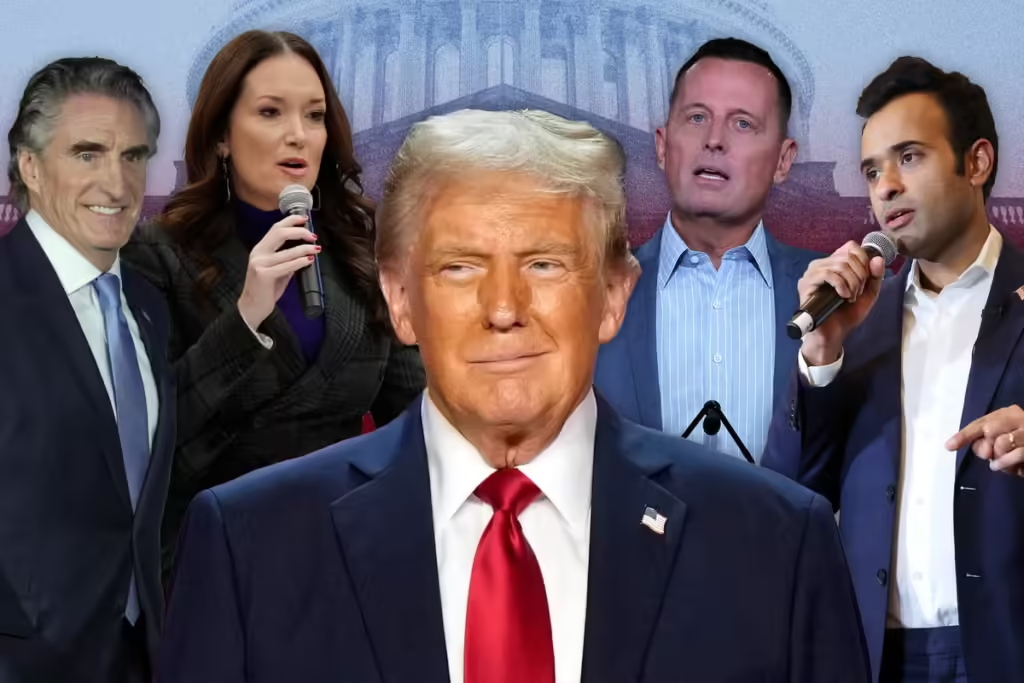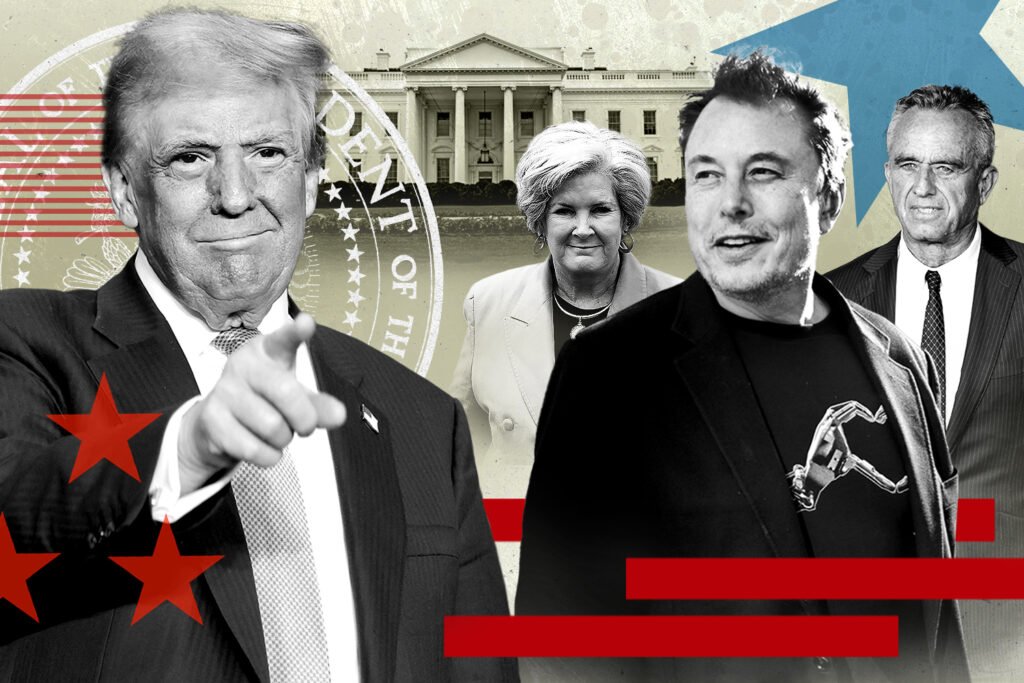Donald Trump has started building his potential cabinet team for a second term. Senator Marco Rubio and former advisor Stephen Miller stand out as leading candidates. Their selection emphasizes Trump’s commitment to immigration policy and foreign relations as central themes that could shape his possible return to the White House. These choices point to major shifts in both domestic and international policy directions.
Trump’s initial cabinet shortlist has several positions that would define his administration’s path. Marco Rubio might serve as Secretary of State, while Stephen Miller could take on a broader role in immigration policy. The list spans vital areas like the Department of Defense, Treasury, and Justice. Judge Aileen Cannon’s name appears among potential nominees for senior positions.
Key Cabinet Positions Filled
President-elect Donald Trump was quick to fill key positions in his incoming administration. His historic appointments point to most important changes in policy direction. The appointments include people who showed strong loyalty to his agenda and previous administration.
White House Chief of Staff
Trump’s appointment of Susie Wiles as White House Chief of Staff marks a historic milestone as the first woman to hold this prestigious position. A seasoned Florida strategist, she showed remarkable success while leading Trump’s political operation for nearly four years. Her expertise spans campaign management and legal affairs. Trump described her as “tough, smart, innovative and universally admired and respected”.
U.S. Ambassador to the UN
The House Republican Conference chair Elise Stefanik, a 40-year-old Representative, will serve as UN Ambassador. She holds the fourth-ranking Republican position in the House and has staunchly defended Trump, especially during his impeachment trials. Trump’s first Senate-confirmation appointment faces challenges due to Stefanik’s limited foreign policy background.
EPA Administrator
Trump selected former New York congressman Lee Zeldin, 44, to lead the Environmental Protection Agency. Zeldin’s legal background matches Trump’s vision of energy deregulation and business-friendly policies. The League of Conservation Voters gave him a 14% lifetime score that shows his support for Trump’s environmental agenda during his time in Congress.
Border Czar
Tom Homan, former acting director of Immigration and Customs Enforcement, will serve as Border Czar. His role will include:
- Oversight of southern and northern borders
- Maritime and aviation security
- Management of deportation efforts
Homan led ICE as acting director from 2017 to 2018 and brings exceptional experience in immigration enforcement. His previous leadership saw deportation arrests increased by 40%, which lined up with Trump’s immigration priorities. He recently stated that enforcement efforts would target public safety and national security threats.
These appointments show Trump’s steadfast dedication to his “America First” agenda. The focus remains on immigration enforcement, environmental deregulation, and a new international diplomatic strategy. Each appointee has showed strong support for Trump’s policies and brings valuable experience to their areas of responsibility.

Potential Picks for Top Roles
Speculation continues to grow about Trump’s cabinet appointments, and several prominent figures have emerged as frontrunners for senior positions in his prospective administration. The selection process brings together a balanced mix of his longtime allies and seasoned government officials.
Secretary of State
Richard Grenell leads the race to become the nation’s top diplomat. Trump calls him “my envoy”. Grenell demonstrated his diplomatic influence through his participation in Trump’s private discussion with Ukrainian President Volodymyr Zelenskyy. The position has another strong contender – Robert O’Brien, Trump’s last national security advisor. O’Brien offers a NATO-friendly perspective and actively maintains diplomatic relationships with world leaders, as shown by his recent discussions with Israeli Prime Minister Benjamin Netanyahu.
Attorney General
Trump’s previous conflicts with the Justice Department have made the leadership selection particularly important. Senator Mike Lee from Utah stands at the top of the candidate list. His 14 years in the Senate and work on the Judiciary Committee make him a strong contender. Several other qualified candidates are also under consideration:
- John Ratcliffe – Former Director of National Intelligence
- Jeffrey Clark – Former assistant attorney general
- Aileen Cannon – U.S. District Judge who ruled favorably in Trump’s classified documents case
Secretary of Defense
Mike Waltz, a retired National Guard Special Forces colonel and current Florida congressman, stands out as a serious contender for Defense Secretary. The first Green Beret to serve in Congress, Waltz is a 15-year veteran who has become one of the strongest China hawks in the House. He maintains direct communication with Trump about national security matters consistently.
Secretary of the Treasury
Several high-profile candidates with extensive financial experience have drawn attention to the Treasury position:
| Candidate | Background | Key Qualification |
|---|---|---|
| Scott Bessent | Hedge fund manager | Met with Trump recently to discuss potential role |
| John Paulson | Investment firm founder | Raised over $50 million at April fundraising event |
| Larry Kudlow | Former National Economic Council Director | Served on outside group promoting Trump’s policies |
The next treasury secretary’s selection holds special importance. They must help execute Trump’s proposed corporate tax reduction from 21 percent to 15 percent and manage new tariffs on foreign goods. Robert Lighthizer’s name has come up in discussions too. His experience as U.S. Trade Representative includes oversight of Trump’s tough tariff policies and negotiations with China, Canada, and Mexico.
These possible appointments show Trump’s focus on picking people who arrange with his policy goals and have showed loyalty to his administration. Each candidate’s background points to a strategy that focuses on tough trade policies, better border security, and a reshaping of international relations that matches Trump’s “America First” agenda.
Trump’s Immigration and Foreign Policy Focus
Trump’s immigration and foreign policy agenda shows a radical change. The core team appointments suggest a return to the hardline approaches from his first term.
Stephen Miller’s Influence
Stephen Miller will likely become Deputy Chief of Staff for Policy and stands as the mastermind behind Trump’s most impactful immigration policies. He coordinated several groundbreaking initiatives during his previous role, including travel bans on Muslim-majority nations and strict refugee admissions limits. Miller’s reach grew as he positioned allies who shared his immigration views in agencies of all types. His calculated approach to policy implementation showed in his preference for phone calls over written communications to keep matters private.
Tom Homan’s Role in Deportations
Tom Homan, the newly appointed Border Czar, must execute Trump’s ambitious deportation agenda. The estimated costs show the massive scale of this undertaking:
| Deportation Component | Estimated Cost (Billions) |
|---|---|
| Arrests | $89.30 |
| Detention | $167.80 |
| Legal Processing | $34.00 |
| Removals | $24.00 |
Homan’s responsibilities cover:
- Southern and Northern border security
- Maritime and aviation security operations
- Coordination of deportation efforts across agencies
These new policies could impact up to 288,000 people through sped-up removal procedures. Homan has stated that the original efforts will focus on people who pose threats to public safety.
US Changes Course in UN and International Relations
The US administration has taken a new direction in how it deals with international partners. Trump’s presidency marked a historic moment when the United States withdrew from the UN Human Rights Council. This unprecedented move showed deep doubts about international organizations. Many experts worry this creates a vacuum that China could fill, especially if the US cuts UN funding and steps back from major international bodies.
US allies have responded to this new foreign policy direction in different ways. Some have started to protect their interests through alternative partnerships. The administration prefers to make deals with individual countries rather than work through international groups. These changes affect many established international systems, from refugee programs to climate deals.
Miller and Homan now work with more power and less supervision. Their influence points to a complete overhaul of immigration policies, both at home and abroad. Their new roles show that immigration enforcement will go beyond just securing borders. These changes could affect how businesses operate and what states can do.

Implications for Trump’s Second Term Agenda
Trump’s predicted second-term policy agenda outlines major changes in several sectors. His new cabinet members will implement the most important reforms.
Environmental Policy Changes
A fundamental change in environmental policies emerges with the new administration’s agenda. The Environmental Protection Agency will undergo substantial restructuring. The administration plans to eliminate specific budgets, staff, and programs that support climate change initiatives. The new EPA leadership aims to withdraw from the Paris Climate Agreement while stopping all climate negotiations.
The administration’s environmental policy changes include:
- Removal of regulatory frameworks that are 8 years old
- Redirection of unspent climate funds from the Inflation Reduction Act
- Faster approval process for natural gas pipelines and drilling operations
- Removal of restrictions on offshore exploration and public land development
Economic and Trade Priorities
Tax reduction and trade protection measures are at the heart of the administration’s economic strategy. Trump’s proposed corporate tax cut from 21% to 15% is the life-blood of his economic policy. The trade agenda has aggressive tariff implementations:
| Trade Policy | Proposed Rate |
|---|---|
| General Import Tariff | 10-20% |
| Chinese Imports | 60%+ |
Middle-class households could face increased costs of approximately $1,700 per year due to these tariff policies according to estimates. Economic projections indicate the original GDP growth could rise by 0.3 percentage points in 2026, though other policies might offset this growth.
National Security Approach
The administration’s defense strategy puts more money into military spending and tougher deterrence measures. Defense spending sits at about 3% of GDP – the lowest in history. The new plan wants to push this above 5% of GDP. Here’s what it covers:
- Naval Force Enhancement
- Rebuilding capabilities to win wars
- Fixing weaknesses in Pacific operations
- Critical Infrastructure
- Restocking ammunition
- Modernizing air defense
- Updating nuclear forces
- Building backup communication systems
Mike Waltz, likely to become National Security Adviser, plans to reshape how the Pentagon buys equipment. He believes “a culture change in how we approach our defense establishment” must happen, especially when bringing in new tech from Silicon Valley.
The way this administration handles international conflicts shows a more aggressive stance. Their Ukraine strategy uses energy sanctions and boosts U.S. energy exports to pressure Russia. This matches Trump’s bigger picture of building American military and economic power while relying less on international organizations.
These policies reach far beyond just money matters. The suggested tariff system could shake up global supply chains and trade partnerships. Research shows that earlier tariffs drove prices up and brought both production and jobs down. New trade limits might do the same.
This new direction marks a big change from current policies. New cabinet members stand ready to make sweeping changes in environmental, economic, and security areas. Success depends on Congress backing these plans and how well the administration guides complex international relationships while keeping the U.S. economy stable.
Conclusion
Donald Trump’s cabinet picks reveal his roadmap to reshape government policies. His appointments showcase a deliberate strategy, from naming Susie Wiles as the first female Chief of Staff to expanding Stephen Miller’s role in immigration policy. Trump has assembled a team of loyal advisers who align with his vision. His choice of seasoned officials like Tom Homan for Border Czar and Lee Zeldin for EPA Administrator points to tough immigration enforcement and fewer environmental regulations. The economic team’s composition suggests a revival of protective trade measures and lower corporate taxes.
These selections herald major changes in domestic and global policies. The new cabinet lineup reflects Trump’s plans to tighten immigration rules and roll back environmental oversight. His administration will likely take a more transactional stance on foreign policy. Strong emphasis on border protection, coupled with economic proposals like higher tariffs and tax reductions, reinforces an “America First” approach. This direction could fundamentally alter U.S. relationships worldwide. Trump’s appointments lay the groundwork for a potential second term defined by bold policy moves and nationalist goals.










Discussion about this post